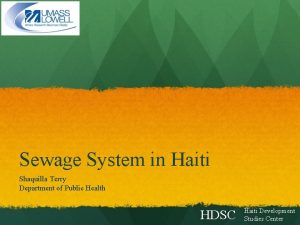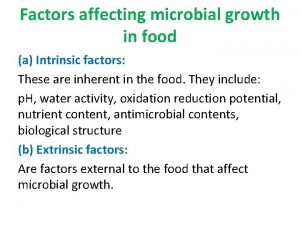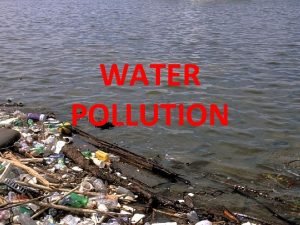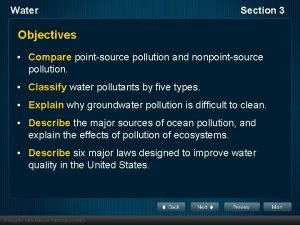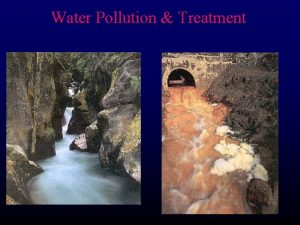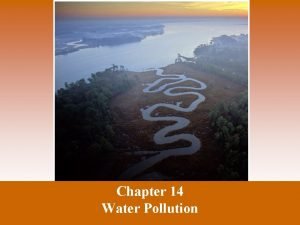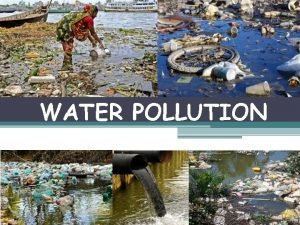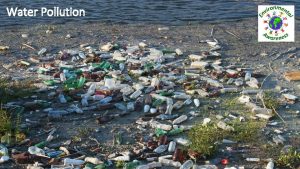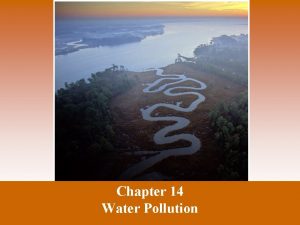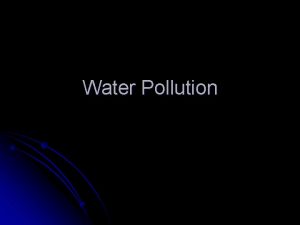Microorganisms and water pollution Effluent treatment Role of









- Slides: 9

Microorganisms and water pollution; Effluent treatment; Role of bacteria and fungi in sedimentation

Water Treatment • Drinking water : Held in a holding tank settling the suspended matter. • Colloidal materials such as clay are removed from water by using flocculant chemicals • Water is treated by filtration : through beds of sand or diatomaceous earth. • Disinfected with chlorine to kill remaining pathogenic bacteria.

Sewage / waste water Treatment • Waste water, that is water after being used, is called sewage. Household water, toilet wastes, industrial wastes and rain water.

Primary Treatment • Removal of solid matter called sludge 40 ~ 60% of suspended solids are removed sedimentation tanks. Flocculating chemicals are added to remove more solids. • Primary treatment removes 25% to 35% of the biochemical oxygen demand (BOD)

Secondary Treatment • Secondary treatment is biological degradation. sewage is aerated vigorously to encourage growth of aerobic bacteria - oxidize the dissolved organic matter to CO 2 and water. Activated sludge systems and trickling filters. • Activated sludge system consists of aeration tank- some of the sludge from a previous batch is added - large number of metabolizing bacteria, yeasts, molds and protozoa. • Species of Zoogloea are important they form flocculant masses in the tank and oxidizes the organic matter. • These flocs settles out organic matter. • Settled sludge is removed for treatment in an anaerobic sludge digester. • Effluent is sent on for final treatment. • Activated sludge systems remove 75% to 95% of the BOD from sewage.


Trickling filters • Sewage is sprayed over a bed of rocks or molded plastic. The rocks provide enough surface area for microbial activity space air to the bottom. • Slimy gelatinous film of aerobic microorganisms grow - metabolize the organic matter. • Trickling filters remove 80 to 85% of BOD.

Trickling filter

Final Treatment • Effluent from secondary treatment is disinfected and discharged on to land or into water. • It is subjected to tertiary treatment. • Tertiary treatment uses physical filtration and chemical precipitation to remove all the BOD, nitrogen and phosphorus from water. • Tertiary treatment provides drinkable water, whereas secondary treatment provides water for irrigation. • Sludge is further digested in an anaerobic sludge digester. Bacteria degrade organic matter and produce methane and CO 2. • First stage of anaerobic sludge digestion, production of CO 2 and organic acids • Next stage organic acids are metabolized to form hydrogen and CO 2. • Third stage there are converted into methane by methane producing bacteria CO 2 + 4 H 2 CH 3 COOH (acetic acid) CH 4 + 2 H 2 O CH 4 + CO 2
 Water and water and water water
Water and water and water water Effluent pumps haiti
Effluent pumps haiti Intrinsic factors affecting the growth of microorganisms
Intrinsic factors affecting the growth of microorganisms Azure web role vs worker role
Azure web role vs worker role Flora ir fauna
Flora ir fauna 2 causes of soil pollution
2 causes of soil pollution Soil pollution images diagram
Soil pollution images diagram Why is water pollution a great concern in southwest asia
Why is water pollution a great concern in southwest asia Conclusion for pollution
Conclusion for pollution Objectives of water pollution evs project
Objectives of water pollution evs project

